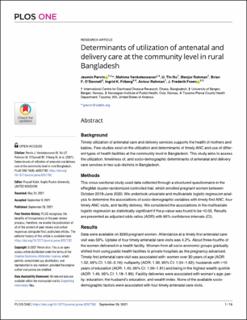| dc.contributor.author | Pervin, Jesmin | |
| dc.contributor.author | Venkateswaran, Mahima | |
| dc.contributor.author | Nu, U. Tin | |
| dc.contributor.author | Rahman, Monjur | |
| dc.contributor.author | O’Donnell, Brian F. | |
| dc.contributor.author | Friberg, Ingrid Kristina | |
| dc.contributor.author | Rahman, Anisur | |
| dc.contributor.author | Frøen, J. Frederik | |
| dc.date.accessioned | 2021-11-24T10:08:20Z | |
| dc.date.available | 2021-11-24T10:08:20Z | |
| dc.date.created | 2021-10-15T14:33:47Z | |
| dc.date.issued | 2021-09-28 | |
| dc.identifier.issn | 1932-6203 | |
| dc.identifier.uri | https://hdl.handle.net/11250/2831243 | |
| dc.description.abstract | Background: Timely utilization of antenatal care and delivery services supports the health of mothers and babies. Few studies exist on the utilization and determinants of timely ANC and use of different types of health facilities at the community level in Bangladesh. This study aims to assess the utilization, timeliness of, and socio-demographic determinants of antenatal and delivery care services in two sub-districts in Bangladesh.
Methods: This cross-sectional study used data collected through a structured questionnaire in the eRegMat cluster-randomized controlled trial, which enrolled pregnant women between October 2018-June 2020. We undertook univariate and multivariate logistic regression analysis to determine the associations of socio-demographic variables with timely first ANC, four timely ANC visits, and facility delivery. We considered the associations in the multivariate logistic regression as statistically significant if the p-value was found to be <0.05. Results are presented as adjusted odds ratios (AOR) with 95% confidence intervals (CI).
Results: Data were available on 3293 pregnant women. Attendance at a timely first antenatal care visit was 59%. Uptake of four timely antenatal care visits was 4.2%. About three-fourths of the women delivered in a health facility. Women from all socio-economic groups gradually shifted from using public health facilities to private hospitals as the pregnancy advanced. Timely first antenatal care visit was associated with: women over 30 years of age (AOR: 1.52, 95% CI: 1.05–2.19); nulliparity (AOR: 1.30, 95% CI: 1.04–1.62); husbands with >10 years of education (AOR: 1.40, 95% CI: 1.09–1.81) and being in the highest wealth quintile (AOR: 1.49, 95% CI: 1.18–1.89). Facility deliveries were associated with woman’s age; parity; education; the husband’s education, and wealth index. None of the available socio-demographic factors were associated with four timely antenatal care visits.
Conclusions: The study observed socio-demographic inequalities associated with increased utilization of timely first antenatal care visit and facility delivery. The pregnant women, irrespective of wealth shifted from public to private facilities for their antenatal care visits and delivery. To increase the health service utilization and promote good health, maternal health care programs should pay particular attention to young, multiparous women, of low socio-economic status, or with poorly educated husbands. | en_US |
| dc.language.iso | eng | en_US |
| dc.publisher | PLoS | en_US |
| dc.rights | Navngivelse 4.0 Internasjonal | * |
| dc.rights.uri | http://creativecommons.org/licenses/by/4.0/deed.no | * |
| dc.title | Determinants of utilization of antenatal and delivery care at the community level in rural Bangladesh | en_US |
| dc.type | Journal article | en_US |
| dc.type | Peer reviewed | en_US |
| dc.description.version | publishedVersion | en_US |
| dc.rights.holder | Copyright 2021 the authors | en_US |
| dc.source.articlenumber | e0257782 | en_US |
| cristin.ispublished | true | |
| cristin.fulltext | original | |
| cristin.qualitycode | 1 | |
| dc.identifier.doi | 10.1371/journal.pone.0257782 | |
| dc.identifier.cristin | 1946267 | |
| dc.source.journal | PLOS ONE | en_US |
| dc.relation.project | Norges forskningsråd: 248073/H10 | en_US |
| dc.relation.project | Universitetet i Bergen: 223269 | en_US |
| dc.identifier.citation | PLOS ONE. 2021, 16 (9), e0257782. | en_US |
| dc.source.volume | 16 | en_US |
| dc.source.issue | 9 | en_US |

